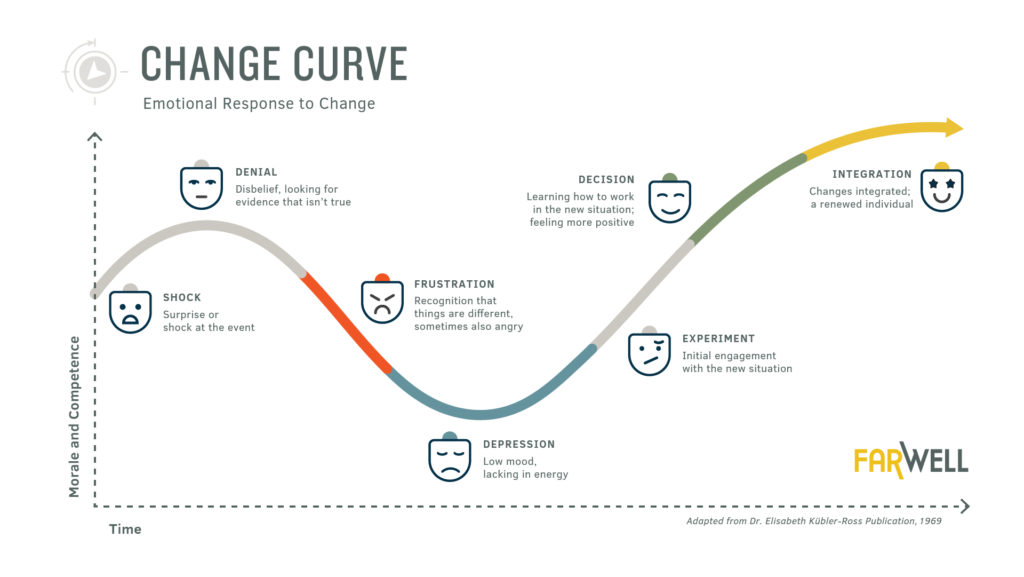Discover advisor articles and other FarWell resources.
Go far. Do well. Call (800) 987-2015
How Leaders Can Emotionally Support Employees During Change | Use the Change Curve as a Conversation Canvas

Press Release: FarWell Partners with Local Businesses to Launch Forward 4 Families, a Sustainable Food System
May 28, 2020
Maintaining Healthy Collaboration and Creativity on Remote Scrum Teams
June 24, 2020The first few months of 2020 have reminded us of the importance of empathy. As leaders, we must understand our employees are dealing with a lot of changes, both in their personal life and at work, which may impact productivity, engagement, and morale.
Despite our best efforts, we still find ourselves in conversations with employees where we feel disconnected like something else is going on that we just cannot pinpoint. This emotional disconnect can lead to work tension for both you and your employee.
Using the Change Curve concept as a common language for communication can help overcome workplace relationship tension. This framework provides a canvas for open, honest, and consistent conversations.
What is the Change Curve?
Elisabeth Kübler-Ross developed the original concept in the 1960’s, then known as the 5 Stages of Grief, to explain the emotions and phases that people go through during the grieving process.
Experts accept the phases Kübler-Ross originally described (or similar phases) as the process most people go through when they experience change. (For change curve effectiveness research study findings, read the Oxford Review Briefing: Is the Change Curve a Myth?) Change Practitioners have since adopted the concept to help leaders manage the people side of change initiatives in the workplace.
Where are You and Your Employee on the Change Curve?

Support Employees Feeling Shock and Denial at the Start of a Change
The first reaction to change is typically shock. Our minds go into fight or flight mode. Though sometimes extreme in nature, this first phase is typically short lived. During this phase, performance tends to dip sharply. We must spend energy trying to understand why this change is happening to us. This dip in productivity is usually a result of fearing the unknown or the fear of not being able to meet new expectations.
Leadership Guidance for Employees Experiencing Shock and Denial
When an employee is in shock or denial, communication is key. Provide as much clarity on the change and why it is happening to take the guesswork out for your employee. Use this time to listen and understand your employee’s initial reaction to the change. Then follow up by acknowledging their feelings. During this stage creating a safe space for your employee to voice their concerns is foundational for constructive future conversations.

Support Employees Experiencing Frustration and Depression amid Change
Once feelings of shock and denial are in the past, anger and frustration set in. During this phase, we look for a scapegoat, someone to blame. Depression surfaces as we come to terms with the reality. At this point, performance is at its lowest.
Leadership Guidance for Employees in the Frustration and Depression Stage
Reassure your team. We are all going through this change together and are experiencing the same set of emotions. Reinforce your role in supporting them by ensuring your team has the knowledge, skills and ability to perform in the new environment.
Ask Clarifying Questions to Better Understand Where There May be Gaps:
- What are your biggest concerns with this change?
- Do you have what you need to perform your work?
- Are there obstacles or roadblocks in your way?
Once you have a better understanding of what may be preventing optimal performance and adoption to the new way of working, take action. This is a great opportunity to show you are a servant leader.
Take the Appropriate Corrective Actions:
- Provide additional training, knowledge or information.
- Reinforce and acknowledge progress to the new way of working.
- Create space to allow the employee to adapt.

Support Employees as They Experiment, Decide, and Integrate Change
Once the dust settles and we have come to terms with the change, we begin to have a positive swing in emotions. We begin to accept the change and work on ways to make the situation the best for us. We may even get excited about the new opportunities.
Leadership Guidance for Employees in the Experiment, Decision, and Integration Stage
During this phase, employees will be curious and excited, and they will have lots of questions. Individuals will respond well to being given specific tasks or responsibilities; communication remains key. Praise and reinforcement will help the change stick.
Peer to peer recognition can be a powerful way to acknowledge your employee’s success in moving through this change. Schedule an open forum for feedback and peer support to strengthen communication between you and your employee. Whether you use your organization’s communication hub or create a shoutout program as part of your change strategy, or both, public acknowledgement can accelerate change.
How Leaders Can Use the Change Curve as a Conversation Canvas with Their Employees
Understand each person reacts to change uniquely. This perspective will help guide conversations with your employees. Many variables can influence how an individual reacts to change such as change history, personality, or how the change impacts them. Knowing where your employee is on the curve will inform what to communicate and when throughout the process.

Using the Change Curve as a Communication Canvas Will:
- Provide a common language to use with your team, reducing the possibility for misunderstanding and confusion
- Allow you to lead with empathy and build trust with your team
- Bring awareness to previously unknown employee concerns and circumstances
How to Start Using the Change Curve:
- Have a meeting with your team to share the Change Curve, what it is, how you want to use it and WHY.
- Begin to use the language in everyday conversations; have fun with it.
- Share an example of a change that you are all going through and where you are on the Change Curve.
- Ask teammates to share where they are on the change curve (leaders may not want to do this in a group setting as employees may not feel comfortable sharing among peers).
- Provide support, lead with empathy, and seek understanding.





